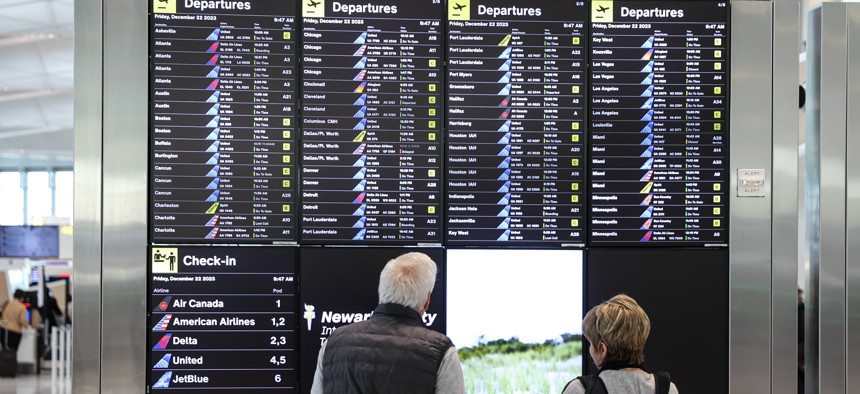Airports are finally back to their pre-pandemic normal, Fitch says

Passengers look at the list of flights at Newark Liberty International Airport ahead of the holiday travel rush in New Jersey. Lokman Vural Elibol/Anadolu via Getty Images
The ratings agency in the last year has upgraded the bond ratings of several major U.S. hubs amid record travel.
You're reading Route Fifty's Public Finance Update. To get the latest on state and local budgets, taxes and other financial matters, you can subscribe here to get this update in your inbox twice each month. You can find a full archive of these newsletters here.
In the early days of the pandemic, planes sat idle at airports across the nation. Now, nearly four years later, passengers endure long TSA lines and crowded terminals. U.S. airports have largely recovered, offering cities a bright spot for their finances even as they struggle with lagging transit demand and still-vacant office buildings.
In the last year, the bond ratings for seven airports have been upgraded by Fitch Ratings, including for major hubs like Chicago O’Hare, New York’s JFK, Houston, Las Vegas and Miami. The company also changed its outlook on another 13 airports and related facilities from “stable” to “positive,” it said in a report. Most airports in the U.S. are owned and operated by local governments.
The rebounding passenger numbers have helped the facilities wean themselves from federal COVID aid, noted Seth Lehman, a senior director for Fitch. “Airports’ enplanement recoveries and effective budgetary management have led to sustained strengthened financial metrics that are no longer dependent on prior receipt of federal grant awards,” he said.
The report only covers actions through fiscal year 2022, but airports have continued to see increased volumes of passengers ever since. Nearly 3 million people, for example, boarded flights the Sunday after Thanksgiving, setting a new record for number of passengers. The 2023 number barely edged out the previous record set in 2013, effectively resetting the meter to pre-COVID levels.
The city of Atlanta announced Wednesday that travel at its Hartsfield-Jackson Atlanta International Airport jumped nearly 12% in 2023 compared to the year before. As one of the world’s busiest airports, it saw 104.7 million passengers last year. That number is still short of the 110 million passengers the airport served in 2019.
Mayor Andre Dickens called the airport’s 2023 performance “a testament to our city’s resilience and the airport’s pivotal role in the economic recovery.”
Those strong performances have occurred even as several airlines experienced meltdowns during the Christmas and 2023 New Year’s travel period.
While the recovery has been widespread, it has been uneven, Lehman said. Airports in tourist destinations like Denver and Miami have added more passengers than they saw before the pandemic. Meanwhile, West Coast airports such as those in Los Angeles, San Francisco and Portland, Oregon, are still lagging behind their pre-pandemic levels.
Those airports tend to depend a lot on business travel, as well as connections to Asia, which have both lagged the broader market, Lehman explained. But they are still in a strong position for a post-pandemic recovery, he said, with strong balance sheets and multibillion dollar construction projects in the works.
The West Coast airports will likely take a year or 18 months to fully recover to their pre-pandemic numbers, he said.
Lehman said airports in general have managed their finances well even as inflation has increased and the Federal Reserve has raised interest rates. They’ve been “cautious with the timing and amount of borrowings so they didn’t put themselves in a position where it would be prohibitively expensive,” he said.
But airports can depend on airlines to cover the cost of most of the improvements, which limits their exposure to external pressure. “That’s why airports are rated very highly for the most part and why they have stable outlooks and very few downgrades even during rough patches,” Lehman said. “Airports tend to get a very strong demand from investors.”
Many high-profile airport rehabilitations—such as the overhaul of LaGuardia Airport in New York and the construction of a new terminal in Kansas City, Missouri—wrapped up during the COVID lull. But Lehman said other major projects are likely to start soon, such as a plan to revamp terminals at Chicago’s O’Hare International Airport. Airports are also trying to determine how best to respond to developments in the airline industry, Lehman added, such as the blocked merger of JetBlue and Spirit airlines, or the potential merger between Alaska and Hawaiian airlines.
“Airports are trying to figure out: How will that affect the character of my passenger? Does the brand name [of the airline] change how I have to invest?” he said.
Daniel C. Vock is a senior reporter for Route Fifty based in Washington, D.C.
NEXT STORY: Pressure mounts to extend low-income broadband subsidy






